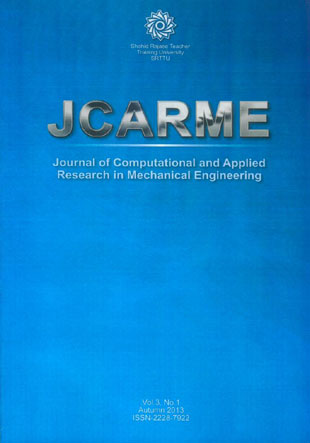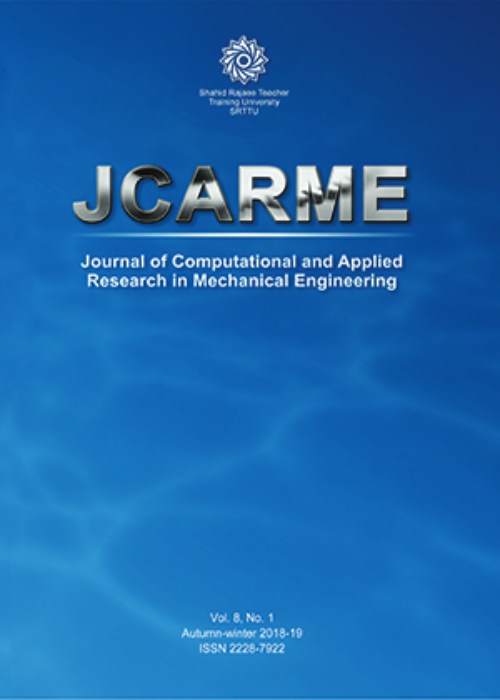فهرست مطالب

Journal of Computational and Applied Research in Mechanical Engineering
Volume:3 Issue: 1, Autumn 2013
- 96 صفحه،
- تاریخ انتشار: 1392/06/03
- تعداد عناوین: 7
-
-
Page 1Austenitic stainless steel sheets have gained wide acceptance in the fabrication of components, which require high temperature resistance and corrosion resistance such as metal bellows used in expansion joints in aircraft, aerospace and petroleum industries. In the case of single pass welding of thinner sections of this alloy, Pulsed Current Micro Plasma Arc Welding (PCMPAW) has been found beneficial due to its advantages over the conventional continuous current process. This paper highlighted development of empirical mathematical equations using multiple regression analysis, correlating various process parameters to pitting corrosion rates in PCMPAW of AISI 304L sheets in 1 Normal HCl. The experiments were conducted based on a five factor, five level central composite rotatable design matrix. The model adequacy was checked by Analysis of Variance (ANOVA). The main effects and interaction effects of the welding process parameters on pitting corrosion rates of the welded joints were studied using surface and contour plots. From the contour plots, it was understood that peak current was the most influencing factor on the pitting corrosion rate. The optimum pitting corrosion rate was achieved at peak current of 6 Amperes, base current of 4 Amperes, pulse rate of 40 pulses/second and pulse width of 50 %.Keywords: AISI 304L, Pulsed current, Micro plasma arc welding, Pitting corrosion
-
Page 13In this paper, simulation and analysis of thin steel cylindrical shells with elliptical cutouts under oblique loading were studied using finite element method. First, the numerical results were validated by the results of experimental test performed by an INSTRON 8802 servo hydraulic machine. Also, the effect of cutout angle (θ), cutout size, cutout position (L0/L) and cutout aspect ratios (b/a) were investigated, where parameter (a) shows size of the cutout along longitudinal axis of the cylinder, parameter (b) is size of the cutout in circumferential direction of the cylinder on the buckling and post-buckling behavior of cylindrical shells with finite element method. It can be concluded that increasing width of the cutout extremely decreased the buckling load while the cutout height was constant. Moreover, changing position of the cutout from the mid-height of the shell toward the edges increased the buckling load.Keywords: buckling, cutout, combined loading
-
Page 27Correct selection of manufacturing condition is one of the most important aspects which should be considered in the majority of manufacturing processes, particularly in the process related to advanced machining process like electrical discharge machining. In electrical discharge machining (EDM), dielectric fluid plays an important role since machining characteristics are greatly influenced by the nature or characteristics of employed dielectric. Moreover, adding various types of abrasives or salt in the fluid at different concentrations also affect the machining performance because of changing dielectric strength property. The present paper addressed the influence of NaNO3 mixed de-ionized water as a dielectric fluid on micro-hole machining performance criteria such as material removal rate (MRR), tool wear rate (TWR), overcut (OC) and taper during machining of D3 die steel plate.Keywords: Electric discharge machining, De, ionized water, D3 die steel, Dielectric fluid, Taguchi method
-
Page 41A numerical study of 3D electrokinetic flows through micromixers was performed. The micromixers considered here consisted of heterogeneous rectangular microchannels with prescribed patterns of zeta-potential at their walls. Numerical simulation of electroosmotic flows within heterogeneous channels requires solution of the Navier-Stokes, Ernest-Plank and species concentration equations. It is known that a 3D solution of these equations is computationally very intensive. Therefore, the well-known Helmholtz-Smoluchowski model is often used in numerical simulation of electroosmotic flows. According to 2D studies on electrokinetic mixing inside heterogeneous channels, existence of vortices within the flow field always increases mixing performance. Hence, it may be expected that similar observations pertain to mixing in 3D flows as well. However, investigations on 3D micromixers identified situations in which existence of vortices had little or no significant benefit to the mixing performance. Findings of the present work indicated degree of flow asymmetry as a key parameter for the mixing performance. Since 3D flows are more capable of developing asymmetrical flow patterns, they are expected to have better mixing performance than their 2D counterparts. The results presented here for different 3D cases showed that mixing performance could be improved significantly depending on the alignment of vortex plane relative to the mixing interface of the fluids. These observations confirmed that 2D simulations of mixing could not fully explain behavior of passive micromixers.Keywords: Mixing, Electroosmotic, Helmholtz, Smoluchowski model, Non, homogeneous
-
Page 53In the present paper، an analysis was carried out to investigate effects of radiation on a free convection flow bounded by a vertical surface embedded in a porous medium with constant suction velocity. It was under the influence of uniform magnetic field in the presence of a homogenous chemical reaction and viscous dissipation with constant heat and mass flux. The non-dimensional governing equations were solved analytically and the expressions were found for velocity، temperature and concentration fields. Also، the expression for skin friction near the plate was derived and the results were discussed in a table.Keywords: MHD, Free convection, Vertical surface, Constant heat, mass flux
-
Page 63This paper modeled heating air of a room through examining free convection in a 3D chamber. The chamber had cold and hot sources with Tc and Th temperatures, respectively. Its other walls were adiabatic. This study aimed at predicting effect of temperature difference, displacement of hot and cold sources and their aspect ratio on flow field, temperature and heat transfer rate. To conduct the study, mass conservation, momentum and energy equations were applied in laminar and 3D states while assuming fluid constant properties, except density, in the power of buoyancy (Boussinesq approximation). Final difference method (FDM) was used for numerical solution of the governing equations based on the volume control and SIMPLE algorithm. According to the modeling results, the most favorable temperature distribution in the chamber (room) was obtained when the heat source (radiator) was located on the wall under the cold source (window). Reducing the distance between the two sources would result in increasing heat transfer from the heating sources.Keywords: Free convection, 3D chamber, Nusselt number, Rayleigh number
-
Page 75Energy equation for turbulent flow in a rotating system was derived in terms of second order correlation tensors, where the correlation tensors were functions of space coordinates, distance between two points and time. To reveal the relationship of turbulent energy between two points, one point was taken as origin of the coordinate system. Due to rotation, the Coriolis force played an important role in the rotating system of turbulent flow. The correlation between pressure fluctuations and velocity fluctuations at the two points of flow field was applied to the turbulent energy equation, in which the Coriolis force and centrifugal force acted on the fluid.Keywords: Energy equation, Turbulent flow, Rotating system, Two, point correlation, Correlation tensor


